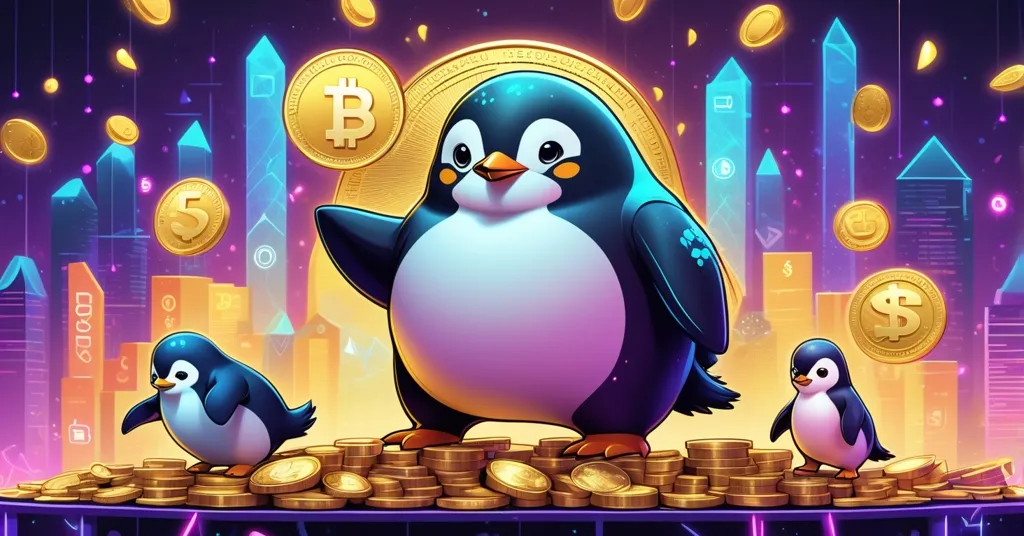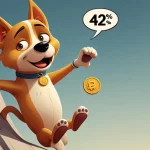Can Little Pepe, Bonk, and Pudgy Penguins Hit a $50 Billion Market Cap in This Crypto Cycle?

Can These 3 Memecoins Smash the $50 Billion Market Cap Barrier This Cycle?
Memecoins are once again stealing the crypto spotlight, with wild speculation swirling that a select few could hit a jaw-dropping $50 billion market cap in this bull cycle. We’re zeroing in on three contenders—Little Pepe, Bonk, and Pudgy Penguins—that are generating serious buzz for their potential to reach this astronomical valuation. Let’s strip away the hype, dissect their strengths, and face the harsh realities of whether this is genius or just another crypto pipe dream.
- Valuation Dream: A $50 billion market cap for a single memecoin, rivaling the entire sector’s current worth.
- Top Picks: Little Pepe, Bonk, and Pudgy Penguins, each with distinct angles to dominate the meme space.
- Make-or-Break Factors: Liquidity floods, retail mania, institutional buy-in, and genuine utility are non-negotiable for this leap.
Memecoins have been the wildcards of crypto since Dogecoin barked its way to billions in 2021, fueled by little more than viral tweets and sheer FOMO—fear of missing out, where everyday investors pile in hoping to catch the rocket. But the game is changing. These tokens are no longer just internet jokes; some are stacking infrastructure, ecosystems, and real-world hooks to justify their existence. Little Pepe, Bonk, and Pudgy Penguins each bring something different to the table, but a $50 billion valuation is a beast of a target. We’re diving deep into their prospects, peeling back the glitter to expose the grit, and asking if these meme machines can truly disrupt finance—or if they’re just another bubble waiting to burst.
Little Pepe: Presale Phenom with Layer-2 Swagger
Little Pepe is the new kid on the block, and it’s already flexing with a presale haul of $19.325 million by the end of Stage 10 at $0.0019 per token, with over 11.25 billion tokens snapped up across sold-out rounds. That’s a step up from earlier figures floating around, and as Stage 11 hits $0.0020 with Stage 12 looming at $0.0021, the momentum’s only growing. For the uninitiated, a presale is an early investment round before a token hits public exchanges, often promising big gains but carrying equally big risks. Little Pepe isn’t just banking on early hype, though—it’s positioning itself as a meme-focused Layer-2 solution, a tech layer built atop a primary blockchain (like Ethereum) to handle transactions faster and cheaper, kind of like adding a fast lane to a clogged highway.
The pitch is slick: ultra-low fees, zero taxes on trades, fair token distribution, and anti-sniper bot tech to stop big players from gaming the launch. They’ve got a CertiK audit—a stamp of security from a respected blockchain auditor—and a high trust score from Freshcoins.io, which rates projects on technical merit. They’re even tossing in a $777,000 giveaway to juice community hype and planning a meme coin launchpad to birth other tokens, hinting at a broader ecosystem. Word is, anonymous experts behind past memecoin hits are steering this toward major exchange listings by 2025, which could send retail interest into overdrive. If you’re curious about the details, check out the presale success and audit specifics.
But let’s slam the brakes for a second. Presales are a minefield—plenty of projects rake in cash only to vanish in a scam known as a rug pull, where devs ditch the project and run with the funds. Even with audits, there’s no guarantee. And a $50 billion market cap? That’s not just a moonshot; it’s a trip to Mars. Little Pepe’s Layer-2 tech sounds promising, but how does it stack against established players like Polygon or Arbitrum? If it’s just marketing fluff, the dream dies fast. This is high-risk, high-reward territory, and while the foundation looks solid, sustaining post-presale buzz is the real test. Some discussions on platforms like Reddit highlight potential risks and scam concerns worth noting. I’m not peddling false promises here—just sizing up the battlefield.
Bonk: Solana’s Meme Mascot with Serious Bite
Bonk struts in as Solana’s resident memecoin champ, already boasting a multi-billion dollar market cap and a rabid fanbase. Solana, for those just dipping into crypto, is a blockchain built for speed and dirt-cheap transactions, making it a darling for decentralized finance (DeFi—think peer-to-peer lending or trading without banks) and non-fungible tokens (NFTs—unique digital collectibles). Bonk feeds off Solana’s growth, with a user base and transaction volume that’s been climbing fast. It’s not just a goofy dog token; it’s got legs with staking options (locking tokens for rewards), NFT payments, and tie-ins with Solana launchpads that help new projects take off.
What gives Bonk its edge is cultural clout—it’s practically Solana’s unofficial mascot, embodying the rebellious, meme-fueled spirit of crypto’s underdog crowd. Its wide retail distribution means it’s already in tons of wallets, a must for long-term traction. If you’re looking for deeper insights into its potential, there are interesting takes on Solana memecoin growth trends. But let’s not get starry-eyed. Hitting $50 billion would mean multiplying its current value many times over, and that hinges on Solana staying ahead of rivals like Ethereum, which is no small feat. Solana’s had hiccups—network outages have plagued it in the past, and if hype overloads the system again, Bonk could take a hit. Still, if retail mania ignites and bigger players start eyeing it, this pup could morph into a wolf. For a broader look at its integration, check out this analysis of Bonk’s market cap potential. I’m watching, not wagging.
Pudgy Penguins: Brand Giant Waddling Into Web3
Pudgy Penguins rounds out the trio, and it’s not your average crypto play. Starting as an NFT collection, it’s ballooned into a legit brand under CEO Luca Netz, with real-world products like Pudgy Toys, children’s books via Random House, and even PEZ candy collabs. Their social media game is nuts—billions of GIF views, a massive TikTok following—and partnerships like Lufthansa’s airline miles program prove they can bridge Web3 with mainstream life. For the newbies, Web3 is the decentralized internet vision powered by blockchain, often clashing with the centralized Web2 giants like Google or Meta. Learn more about their origins in this detailed breakdown of Pudgy Penguins’ brand journey.
The $PENGU token, launched on Solana in December 2024, ties this empire together with utility in marketplace fees and as in-game currency for Pudgy World, a blockchain platform with wallet-less onboarding to ease normies into crypto. They burned over 12 billion unclaimed tokens to shrink supply and prop up value—a bold tokenomics move (that’s the economic design of a token, folks). This isn’t mere speculation; it’s a calculated stab at making $PENGU the lifeblood of a cultural juggernaut. Analysts are all over its market moves, and its presence in places like Walmart shelves makes a $50 billion cap seem less like a meme and more like a mission. For more on their expansion, see this overview of their growth beyond crypto. That said, the token’s post-launch surge and dip scream caution—hype fades without flawless follow-through, and over-commercialization could alienate the crypto purists who crave raw decentralization.
Historical Context: Memecoin Madness of Yesteryear
Before we get too cozy with these shiny new players, let’s flashback to 2021, when Dogecoin hit a peak of around $88 billion and Shiba Inu wasn’t far behind, all on the back of Elon Musk tweets and Reddit frenzies. That was a bull run where Bitcoin itself blasted past $60,000, dragging every speculative asset along for the ride. Retail FOMO was the fuel—everyday punters tossing cash at anything with a cute logo, fundamentals be damned. The memecoin sector today sits near $50 billion total, per recent CoinMarketCap data, meaning one token hitting that mark solo would need to Hoover up the entire pie. Possible? Maybe in a hyper-liquid market. Likely? That’s a stretch, even with history as a guide. For a broader perspective, this overview of memecoin market dynamics provides useful context.
Market Dynamics: What Fuels a $50 Billion Valuation?
Reaching a $50 billion market cap—basically the total value of a token, found by multiplying its price by circulating supply—isn’t just about memes going viral. It’s a brutal mix of market liquidity (cash flowing into crypto), investor psychology, and hard utility. Dogecoin’s peak came during a liquidity flood; today, Bitcoin’s dominance is creeping up, often sucking capital from altcoins like memecoins when macro conditions tighten—think rising interest rates or inflation fears. Yet memecoins live on retail exuberance. Platforms like TikTok and Reddit can turn a token into an overnight sensation, as Shiba Inu proved. For additional insights into this trend, take a look at this analysis of memecoins reaching massive valuations.
For Little Pepe, Bonk, or Pudgy Penguins to hit the jackpot, they need that cultural tidal wave plus extras: institutional money (a long shot for pure memes), regulatory green lights (dicey in places like the US), and real adoption beyond trading bots. Utility is the new battleground. Little Pepe’s Layer-2 could, if it’s not just hot air, handle thousands of transactions per second—way beyond Ethereum’s sluggish base layer at 15-30. Bonk’s Solana DeFi hooks tap billions in monthly volume. Pudgy Penguins could pull non-crypto folks via toys and games, a crowd Bitcoin’s stoic “digital gold” vibe can’t touch. But the flip side stings: one scam rumor, one network glitch, or one SEC hammer could crater sentiment faster than a bad tweet. I’m all for sticking it to centralized finance, but I’m not betting my Bitcoin stash on a miracle without cold, hard execution.
The Ugly Side: Risks and Reality Bites
Let’s not sugarcoat this. Memecoins, for all their charm, are a volatility vortex. Prices can swing 50% in a day, wiping out leveraged traders or latecomers. Regulatory clouds loom large—governments worldwide are itching to clamp down on speculative assets, especially in major markets like the US and EU, where unclear rules could slap projects with fines or outright bans. Then there’s the scam factor. Rug pulls are rampant; even audited projects can flop if devs lose steam or insiders dump tokens. Little Pepe’s presale success is no shield against a post-launch fade. Bonk’s Solana reliance means one network outage could spook holders. Pudgy Penguins risks diluting its crypto cred with too much mainstream fluff, alienating the decentralization diehards.
I’m a sucker for disruption—anything that rattles the cages of traditional finance gets my nod. But the crypto graveyard is packed with “next big things” that turned out to be nothing. A $50 billion cap for any of these tokens is a speculative fever dream until they prove they’re more than memes—they need to be movements. Even in a bull market flush with cash, the odds are steep. Compare it to Bitcoin’s cycles: when BTC peaks, altcoins often lag or crash soon after. Memecoins might ride the wave, but staying afloat post-hype is the killer challenge.
Key Takeaways and Burning Questions
- What sets Little Pepe apart in the memecoin frenzy?
Its Layer-2 tech for speed and low fees, a $19.3 million presale, and CertiK audit give it a rare blend of innovation and credibility among hype-driven peers. - How does Bonk capitalize on Solana’s ecosystem?
Bonk leverages Solana’s fast, cheap transactions and booming DeFi/NFT sectors, embedding utility via staking and payments to outgrow its meme roots. - What makes Pudgy Penguins a cultural standout?
Its mainstream brand power through toys, books, and social media, plus $PENGU’s role in gaming and marketplaces, positions it as a Web3-to-Web2 bridge. - Is a $50 billion market cap realistic for any memecoin?
It’s a long shot, even with liquidity and retail mania. Historical peaks like Dogecoin’s $88 billion show it’s possible, but fundamentals and execution must align perfectly. - Are memecoins evolving beyond pure speculation?
Yes, some are—with tech, audited systems, and real use cases—but the specter of scams and volatility means skepticism remains a must for most projects. - What are the biggest threats to these sky-high valuations?
Wild price swings, regulatory crackdowns, and scam risks like rug pulls could derail even the strongest contenders, no matter the hype. - How do memecoins fit into the broader decentralization fight?
Their absurdity could be a Trojan horse, sneaking decentralized tech into the masses, but only if they deliver value beyond laughs and quick bucks.
What to Watch in 2025
As we barrel through this cycle, keep your radar locked on a few pivotal signals. Will Little Pepe’s Layer-2 tech actually deliver, or is it just a shiny buzzword? Can Bonk keep riding Solana’s wave if network hiccups resurface? Does Pudgy Penguins’ brand magic translate to lasting token demand, or will it overplay the corporate card? And bigger picture—will memecoins, for all their chaos, sneak decentralization into the mainstream, or just pad the pockets of a lucky few? I’m rooting for anything that chips away at the old financial guard, but my skepticism is sharper than a Bitcoin private key. These tokens have potential to rewrite the playbook—or become cautionary tales. Stay cautious, stay curious, and let’s see if memes can make history.



